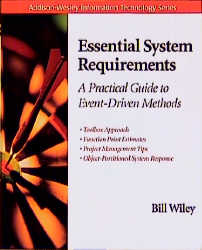
Essential System Requirements
Addison Wesley (Verlag)
978-0-201-61606-4 (ISBN)
- Titel ist leider vergriffen;
keine Neuauflage - Artikel merken
It is a costly fact that a large percentage of information system development projects fail--ending up over budget, behind schedule, or so poorly designed that they remain unused. Essential System Requirements targets the discovery and definition of critical system requirements in the analysis phase of system development--where good design is vital to the success of a project. This book explores a design methodology that involves users early on to describe essential business events. These events then partition the system response into logical, more easily managed segments. The result is a conceptual model that reflects real business needs and accelerates the entire delivery process. Essential System Requirements assembles the information developers need to understand and apply this methodology and condenses it into a concise and practical guide. This book reviews the development life cycle, highlights the importance of requirements, and introduces the concept of business events.It provides a detailed description of experience-based techniques and methods to analyze, specify, and partition the requirements of an information system, covering project tasks and procedures, system behavior, data and process modeling techniques, and the transition to physical design.
Inside you will also find a clear description of function point estimation, a promising method of estimating the time and cost of future software projects based on system requirements. In addition, Essential System Requirements shows you how responses to business events can be partitioned across object classes, focusing on the application of use cases in event-driven requirements analysis. Also featured: *A middle-out strategy that is similar to the way humans typically categorize and classify objects. *The need for rapid development combined with a sound, scalable software architecture (RAAD). *A discussion of the changing world market and the related need for adaptive business systems. *The impact of making a major paradigm switch in a corporate software environment and ways to move to an event-driven approach.*The specification of a system response to an event using a business scenario, data model, process model, entity life cycle, and event/entity interaction (CRUD) matrix. With this book as your guide, you will have at hand proven techniques for defining the systems your clients want and setting the stage for a smoother, faster, more easily managed development process.
0201616068B06012001
Bill Wiley is a consultant specializing in event-based methodology and system requirements definition. He has twenty-five years of experience in virtually all aspects of application development, spanning a wide range of systems, user groups, corporate environments, and hardware platforms. He spent eight years at the Johnson Space Center in Houston and has sixteen years of experience with manufacturing systems. His consulting experience includes methodology training and the application of event-driven analysis and design methods; he has also facilitated joint design sessions. Mr. Wiley most recently researched the application of various event-based methods during a nine-year tenure as an assistant professor of information systems at Taylor University. 0201616068AB04062001
Preface. Acknowledgments. Introduction. An Executive Overview. Contract Litigation Issues. Modern System Development Methods with Events. The Focus of This Book. The Organization of This Book. How to Use This Book. I. BUSINESS EVENTS AND SYSTEM DEVELOPMENT. 1. Foundational Concepts. The System Development Life Cycle. The Critical Nature of Requirements. Building the Right System. Verifying System Requirements. Why Business Events? Business Events and System Requirements. System Partitioning. 2. The Pervasive Nature of Business Events. Partitioning the Physical System. The Physical Distribution of Business Events. Business Events and Project Management. Business Events and Estimating Project Size. 3. Business Events and Methodology. Middle-Out Strategy. Conceptual Models and the Reduced Role of the DFD. Business Events and RAD. Responding to Change. Adopting an Event-Driven Approach for Your Organization. Methodology Overview. II. EVENT-PARTITIONED SYSTEM REQUIREMENTS. 4. Project Procedure for Event Partitioning. System Behavior. System Data. System Process. Data/Process Interaction. Transition to Physical Design. Event-Partitioned Deliverables. 5. System Behavior. Business Event. System Response. System Context. Business Event Scenario. Functional Structure. 6. System Data. Data Entity. Entity Relationship. Entity Attribute. Data Normalization. 7. System Process. Event Response. Process Decomposition. Event-Response Specification. 8. Data/Process Interaction. CRUD Associations. Entity Process View. Entity Life Cycle. 9. Transition to Physical Design. System Releases. System Distribution. Conceptual Event Models to Physical Models. III. ESTIMATING SOFTWARE PROJECTS. 10. Function Point Estimates and Events. Difficulty of Estimating Software Projects. Sources of Errors. Methods of Estimation. Function Point Estimating. Application of Function Point Count. Automated Estimating Tools. The Future of Function Point Analysis. Integration of Events and Function Points. 11. Function Point Example. Data Function Types. Transactional Function Types. General System Characteristics. Adjustment to Function Points. Example Summary. IV. OBJECT-PARTITIONED RESPONSE TO EVENTS. 12. Common Techniques. Event-Driven User Interface. The System Response. Transitional Methods. 13. Class Operations. Function Assembly by Class. CRUD Associations. 14. Class Interaction. Event-Response Process Map. Application-Control Class. Object Collaboration. Appendix A. Collection of Examples. Appendix B. Model Notation and Symbols. Appendix C. IFPUG General System Characteristics Tables. Glossary. References. Index.
| Erscheint lt. Verlag | 12.1.2000 |
|---|---|
| Verlagsort | Boston |
| Sprache | englisch |
| Maße | 187 x 232 mm |
| Gewicht | 430 g |
| Themenwelt | Informatik ► Software Entwicklung ► Objektorientierung |
| ISBN-10 | 0-201-61606-8 / 0201616068 |
| ISBN-13 | 978-0-201-61606-4 / 9780201616064 |
| Zustand | Neuware |
| Haben Sie eine Frage zum Produkt? |
aus dem Bereich


